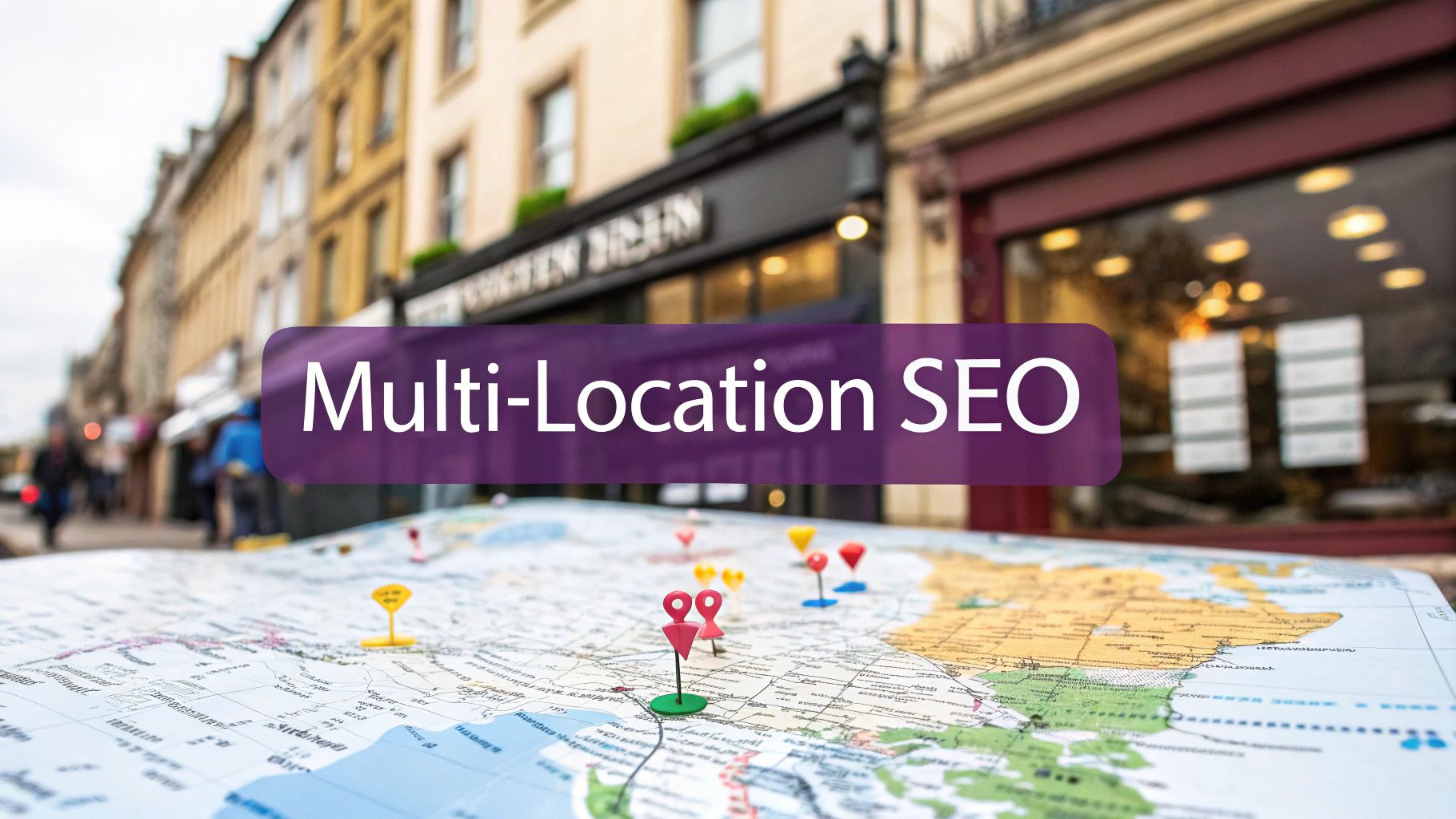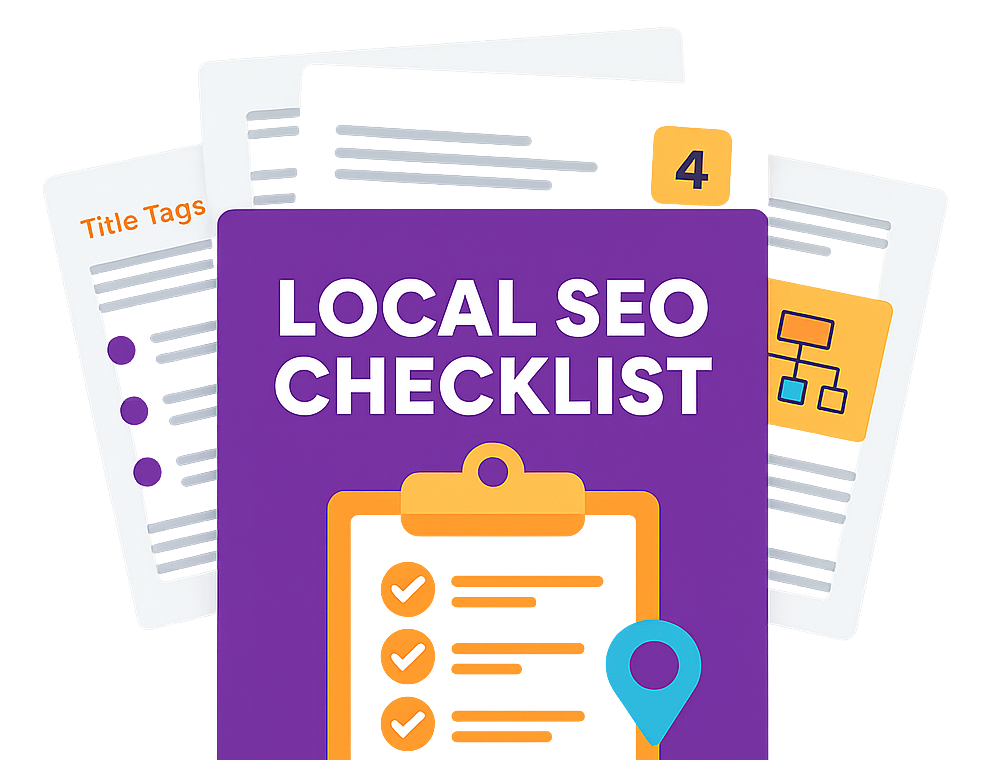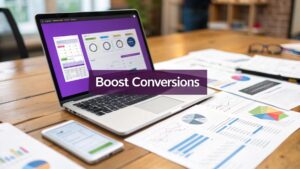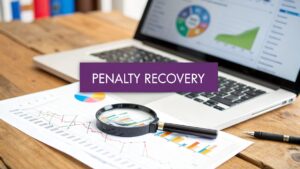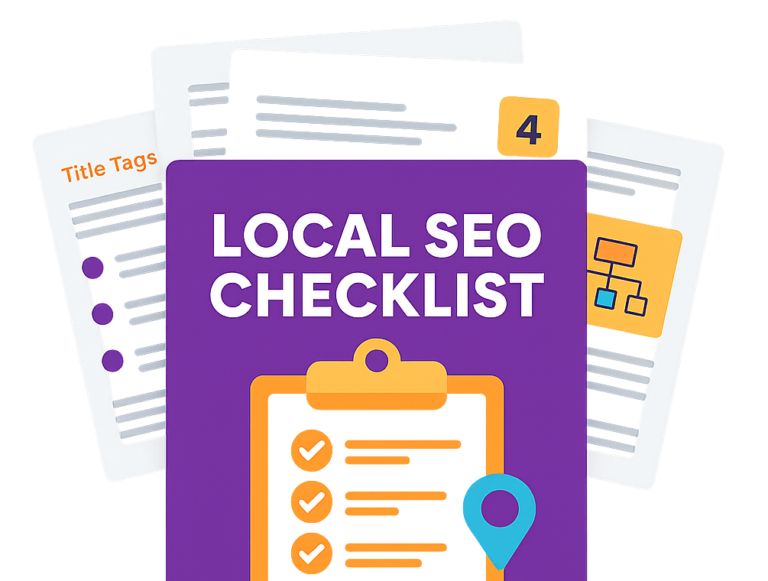Dealing with SEO for a business with multiple locations is all about finding that sweet spot between a unified brand strategy and localised flexibility. The goal is to make sure each branch truly connects with its community. This boils down to building unique location pages, fine-tuning individual Google Business Profiles, and managing local citations to get seen where it counts.
Building Your Multi-Location SEO Foundation
Scaling your local SEO across several branches can seem like a massive undertaking, but it’s a non-negotiable for any business that wants to own the local search results. A generic, one-size-fits-all approach just doesn't work anymore. Let’s be honest, customers in Manchester have entirely different needs and search habits than those in Bristol, and your online presence needs to reflect that.
This is where a solid framework comes in. The best way to think about it is a 'hub and spoke' model. Your main website is the central hub, setting the tone for brand consistency and overall authority. Each of your physical locations is a 'spoke', with its own tailored online presence designed to pull in and serve its specific local audience.
This visual breaks down the core pillars you need for a winning multi-location SEO strategy.

As you can see, a solid foundation rests on three things working together: dedicated location pages, optimised Google Business Profiles, and hyper-local content.
The Power of Local Intent
This localised approach isn't just a hunch; it's backed by some pretty compelling data. In the UK, a staggering 46% of all Google searches have local intent. That means nearly half of all people searching are looking for something nearby.
And it gets better. Searches for terms like "near me" have skyrocketed by an incredible 500% over the last five years. This isn't just a trend; it's a massive shift in how consumers find solutions right on their doorstep.
A successful local SEO strategy for multiple locations isn’t about duplicating your workload. It’s about creating a repeatable, scalable system that allows for local customisation while keeping the core brand message strong and consistent.
To see how this fits into the bigger picture, it's worth exploring a comprehensive guide on building a robust Franchise Marketing System. Getting this foundation right prepares you for the more granular tactics we'll cover next. And to make sure you've got all your bases covered, our local SEO checklist is a great resource to follow.
Crafting High-Performing Location Pages
For any multi-location business, your website is the central hub for all your local SEO efforts. This makes dedicated location pages an absolute must-have. But here’s where so many businesses go wrong: they just duplicate a template and swap out the city name. That’s a huge missed opportunity.
Think of each location page as a digital storefront for that specific branch. It needs to be individually crafted to connect with the local community.
This approach is non-negotiable because customers are actively looking for local solutions. In fact, for UK businesses with a physical presence, a staggering 69% of total digital traffic can come from local and organic search combined. To drill down even further, searches with local intent account for 22.6% of all website traffic in the UK. This number alone shows just how critical these pages are for pulling in nearby customers.

Making Each Page Unique
Authenticity is the name of the game. Each page has to feel like it was built specifically for that town or city. You achieve this by weaving unique, localised content throughout the page, showing a real, genuine connection to the area.
Here are a few practical ways to do this:
- Feature the Local Team: Put a human face on the business. Add photos and short bios of the staff who actually work at that branch. It builds instant trust.
- Showcase Local Testimonials: Display reviews from customers in that specific area. A glowing review from someone in "central Bristol" means a lot more to a Bristol-based searcher than a generic one.
- Reference Nearby Landmarks: Mention well-known local spots to ground your business in the community. A Manchester location page, for instance, could mention, "You can find us just a short walk from the Northern Quarter."
- Embed a Unique Google Map: This is a simple but crucial one. Every page must have an embedded map pointing directly to that specific location, not a general map of all your branches.
As you're crafting these pages, understanding lead capture landing page best practices is also key to converting that local traffic into actual customers.
Optimising Technical On-Page Elements
Beyond the unique content, you have to get the technical on-page optimisation right. This is how you signal relevance to search engines. Each and every location page needs its own distinct set of metadata that tells Google exactly what it’s about and where it is.
Your focus should be on these core elements for each page:
- Title Tag: This is your most important on-page signal. It needs to include your main service and the specific location. For example:
<title>Expert Plumbing Services in Leeds | Your Brand</title>. - Meta Description: Think of this as your sales pitch in the search results. Make it compelling and include the location and a call to action. Something like, "Need a reliable plumber in Leeds? Contact our local team today for a free quote."
- H1 Heading: The main heading on the page should clearly state the service and location, reinforcing the intent of the title tag (e.g.,
<h1>Your Trusted Plumber in Leeds</h1>).
Pro Tip: Make sure you implement Local Business schema markup on every single location page. This structured data gives search engines crystal-clear, machine-readable info about each branch—name, address, phone number, opening hours. It's a huge advantage in local search results.
Mastering Google Business Profile at Scale
Once your high-performing location pages are live, the next piece of the puzzle is your Google Business Profile (GBP). For any multi-location business, this isn't just about getting listed; it's about turning each profile into a dynamic, localised front door for every single branch. Mastering this at scale is a balancing act—you need central control, but you also need to inject some local flavour.
While Google gives you bulk management tools for the basics, like updating opening hours across the board, the real wins come from digging deeper. This means going beyond simple consistency and treating each profile as its own unique marketing channel that speaks directly to the local community.
Going Beyond Basic Information
A complete profile is just the starting point—it's the bare minimum. To actually stand out, each GBP listing needs a steady stream of localised activity. This tells Google you’re an active, relevant part of that specific community. This can't be random; it requires a systematic approach to managing location-specific content.
Here are the key areas to focus on for each individual profile:
- Location-Specific Q&As: Don't wait for customers to ask questions. Proactively populate the Q&A section with common queries for that specific branch. A restaurant in a busy city centre, for instance, might add a Q&A about parking, whereas a suburban branch might focus on its family-friendly facilities.
- Localised Google Posts: Use Google Posts to shout about events, promotions, or news that are only relevant to that location. A "Meet the Manchester Team" event or a "Bristol Branch Summer Sale" post is far more engaging than a generic, company-wide announcement.
- Unique Photo Uploads: Regularly add high-quality photos that show off the individual character of each branch. We're talking pictures of the local team, shots of the interior, and even photos of your storefront decorated for a local festival.
The Unbreakable Rule of NAP Consistency
Across every single digital touchpoint—from your website to the smallest online directory—your Name, Address, and Phone number (NAP) details must be perfectly consistent. This is completely non-negotiable for multi-location businesses.
Even a tiny discrepancy, like using "St." on one profile and "Street" on another, can confuse search engines and seriously damage your local rankings.
Maintaining absolute NAP consistency across all your GBP listings is one of the most powerful trust signals you can send to Google. It proves you are who you say you are, where you say you are.
The data backs this up. Businesses that get their NAP identical everywhere can see a 28% boost in local search rankings. And with GBP factors contributing to over 19% of local ranking signals, getting this right is crucial.
What's more, regularly updated profiles appear 2.8 times more frequently in the coveted top 3 map results. You can discover more insights about these GMB statistics on sqmagazine.co.uk.
To help you get every profile perfectly tuned, we’ve put together a handy checklist.
GBP Optimisation Checklist for Each Location
This table breaks down the essential tasks you should perform on every single Google Business Profile. Running through this checklist ensures nothing gets missed and helps maintain that all-important consistency, giving each location its best shot at maximum visibility.
| Optimisation Element | Action Required | Why It Matters |
|---|---|---|
| Business Information | Verify NAP is 100% accurate and matches the location page. | Builds trust with Google and prevents user confusion. |
| Categories | Select a primary category and all relevant secondary categories. | Helps Google understand your services and show you in relevant searches. |
| Service Area | Define the specific towns, cities, or postcodes you serve. | Crucial for service-based businesses to appear in "near me" searches. |
| Photos & Videos | Upload 10+ high-quality, location-specific images and a video tour. | Visuals increase engagement and make your listing more appealing. |
| Google Posts | Publish at least one localised post per week (offers, events, updates). | Signals to Google that your business is active and relevant. |
| Q&A Section | Pre-populate with 3-5 common questions and clear answers. | Addresses customer pain points upfront and showcases expertise. |
| Reviews | Actively request reviews and respond to every single one (good or bad). | Strong social proof that heavily influences both rankings and customers. |
Following these steps for each location turns your GBP listings from simple placeholders into powerful tools for attracting new customers. You can learn more about perfecting each listing in our detailed article on Google My Business optimisation.
Scaling Your Local Citation Strategy
Beyond Google, your business details are floating around a huge ecosystem of online directories, apps, and data aggregators. This is where citation management comes into play—the vital process of making sure every mention of your business's Name, Address, and Phone number (NAP) is bang-on accurate everywhere online.
Think of each correct citation as a little vote of confidence. When search engines see the exact same NAP details for your Manchester branch on Yell, Thomson Local, and your own website, it solidifies their trust that you’re a legitimate business, located exactly where you say you are.
But inconsistencies? They send mixed signals and can seriously mess with your local search rankings.

Performing a Citation Audit
Before you even think about building new citations, you need a clear picture of where you stand right now. A citation audit involves hunting down every existing mention of your business online to find and fix any dodgy information. This is absolutely critical for any business that has moved, rebranded, or changed phone numbers in the past.
You could start this manually by searching for your business name (and any variations) online. But for multiple locations, this quickly becomes a soul-destroying, time-consuming task. This is where specialised tools can save your sanity and a lot of effort.
Manual Management Versus Automated Services
When you're handling citations for multiple locations, you'll hit a crossroads: do it all in-house or pay for an automated service? Each path has its pros and cons.
Manual Citation Management:
- Pros: You get total control over every single listing. It can also be cheaper if you only have a few locations to worry about.
- Cons: It's incredibly time-intensive and a nightmare to scale. It’s far too easy to miss listings or make typos when you’re juggling dozens of directories for multiple branches.
Automated Citation Services:
- Pros: A massive time-saver. These services push your correct NAP data out to dozens, sometimes hundreds, of directories at once. They also keep an eye out for any new inconsistencies that pop up.
- Cons: They come with a subscription fee, which can add up if you have a lot of locations. You also give up a bit of direct control over individual listings.
For most businesses with more than a handful of locations, the sheer efficiency and accuracy you get from an automated service easily outweigh the cost. The time you save lets your team focus on other high-impact parts of your local SEO for multiple locations campaign.
Top-Tier UK Directories
While global directories are important, you absolutely need a strong presence on reputable UK-specific platforms. These are the directories British customers actually know and trust, and they send powerful local relevance signals to search engines.
Get your initial efforts focused on locking down accurate listings on these key UK sites for each of your locations:
- Yell: The digital version of the Yellow Pages is still one of the most authoritative business directories in the UK.
- Thomson Local: A long-standing and highly trusted source for local business info.
- Scoot: A powerful network that feeds data to other big names like The Sun and The Independent.
- 192.com: A well-known directory for finding people, businesses, and places across the UK.
Getting your NAP perfectly consistent across these core platforms is a foundational step toward building a dominant local presence. For a deeper look at integrating citations with your other marketing efforts, check out our complete guide on local SEO strategies.
Generating and Managing Local Reviews
Online reviews are the new word-of-mouth, and they pack a serious punch when it comes to shaping both your search rankings and what customers decide. Seeing a steady flow of positive, recent reviews for a specific branch is a massive trust signal for Google and for anyone thinking about walking through your door. But trying to manage this across multiple locations without a clear, scalable system? That's a recipe for chaos.

The secret is to make leaving feedback completely frictionless. Customers are far more likely to share their thoughts right after a great experience, so your methods for asking have to be timely and dead simple.
Encouraging Customer Feedback Systematically
Getting a consistent stream of reviews doesn't just happen on its own; it requires a structured approach. You need to weave review requests into your customer journey right at that peak moment of satisfaction. This way, you're asking at the perfect time without ever coming across as pushy.
Here are a few effective, non-intrusive ways to get the ball rolling:
- Automated Email or SMS Follow-ups: After a purchase or service, a simple, personalised message asking for their thoughts goes a long way. Make sure to include a direct link to your Google Business Profile review page to remove any and all friction.
- In-Store QR Codes: Pop a QR code at the till point or on tables that links straight to your review platform. A simple sign like, "How did we do? Scan to share your feedback!" can work wonders.
- On Receipts or Invoices: Tacking on a short, friendly request for a review at the bottom of printed or digital receipts is a low-cost tactic that’s surprisingly effective.
Responding to Every Single Review
How you respond to reviews is just as important as how you get them. Responding to both the glowing five-star comments and the not-so-great ones shows you actually value what customers have to say and are actively engaged. For a multi-location business, this is a golden opportunity to put excellent customer service on display at the local level.
Responding promptly and professionally is absolutely non-negotiable. Aim to get back to people within 24-48 hours to show you're paying attention.
Pro Tip: Create a set of response templates for your team. These shouldn't be robotic, copy-and-paste replies. Think of them as frameworks that can be quickly personalised with the customer's name and a specific detail from their review. This helps maintain a consistent brand voice while saving a ton of time.
When a negative review comes in, the goal is always to take the conversation offline and show you’re committed to making things right. A solid response acknowledges their experience, offers an apology, and provides a direct contact (like a manager's email) to sort it out. This public display of accountability can often turn a bad situation into a positive one.
For this to work at scale, you have to empower your local managers to handle their own reviews. They're the ones with the direct context of what happened. Giving them proper training and clear guidelines ensures your brand integrity stays intact across all branches. This approach is particularly powerful for franchises, where local ownership is a huge part of the puzzle, as we detail in our guide to local SEO for franchisees.
Common Questions on Multi-Location SEO
When you're trying to nail down a local SEO strategy for multiple locations, a few common roadblocks always seem to pop up. Getting these details right from the start is what separates a frustrating, disjointed effort from a scalable campaign that actually drives customers to every single one of your branches. Let's dig into some of the most frequent questions I hear from businesses.
How Do I Avoid Creating Duplicate Content on My Location Pages?
This is a big one, but it’s entirely avoidable with the right approach. While your core service descriptions will naturally be similar across pages, the trick is to inject each page with substantial, unique content. This is how you signal to search engines that every page offers distinct value to its local audience.
Don't just swap the city name and call it a day. To create genuine uniqueness, you can:
- Introduce the local team with their photos and short bios.
- Showcase testimonials and case studies from customers in that specific area.
- Mention nearby landmarks or describe the local neighbourhood your branch is in.
- Embed a location-specific Google Map for that branch.
- Pull unique, local reviews directly onto the page.
Each of these elements helps build a page that feels authentic to its community and, just as importantly, looks completely distinct in Google's eyes.
Should I Use One Central Phone Number or Unique Local Numbers?
Always, always use a unique, local phone number for each physical location. I can't stress this enough. It’s a non-negotiable part of your NAP (Name, Address, Phone number) consistency and acts as a powerful local ranking signal. A local area code immediately reinforces your connection to that community for both customers and search engines.
Of course, you can still list a central number as a secondary contact option on your website. But the primary number featured on each location page—and its matching Google Business Profile—must be the direct local line.
Using local numbers isn't just an SEO play; it's a customer experience win. It tells potential customers they're connecting directly with the people at their nearest branch, which builds immediate trust and makes them far more likely to get in touch.
What Is the Best Way to Manage GBP Posts Across Many Locations?
Trying to manage Google Business Profile posts at scale can feel like a full-time job, but this is where third-party scheduling tools become your best friend. Platforms built for social media management or specialised local SEO tools often let you create post templates that can be customised and scheduled across all your profiles at once.
This approach gives you the perfect balance. You can maintain brand consistency for big announcements or nationwide promotions, while still empowering local managers to add their own unique updates. Maybe it's a post about a community event or a promotion specific to that one branch. You get the best of both worlds: central control with a genuine local flavour.
Ready to turn your multi-location SEO strategy into a powerful customer acquisition engine? Bare Digital offers expert, data-driven SEO services designed to get all your locations ranking. Start with our free SEO Health Check to see where you stand. Get your free SEO proposal today.

